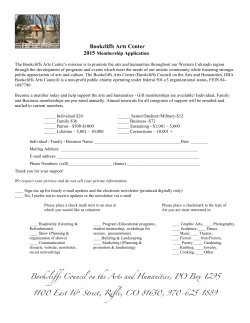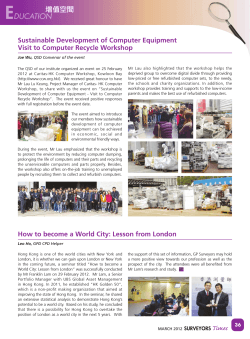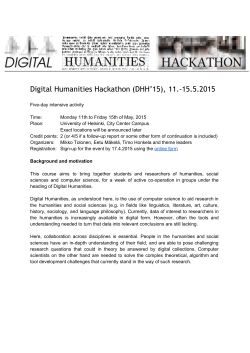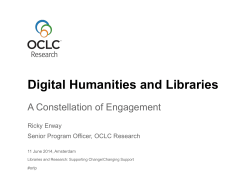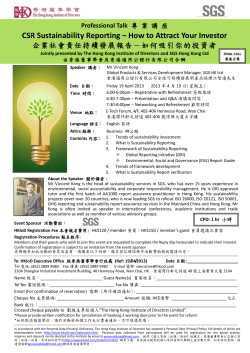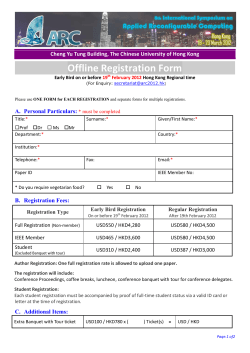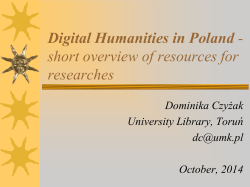
Document 237646
King’s College S1 Integrated Humanities Class: __________________________ Worksheet (II) (A) My School, Our District P1 Name: _________________________( ) School History What is History? Three meanings of the word ‘history’ 1. History as An event is a human activity. Any human activity that has happened – is history. 2. History as of past events To remember past events, we need to make a record of them. However, we only record the important ones. 3. History as the of the record of past events To understand the importance of past events and to learn from them, we must study them. Study the pictures below, and then answer questions (a) and (b). Cover of Harry Potter and the Order of the Phoenix Picture (i) Picture (ii) (a) Picture (i) is about the fiction- Harry Potter. Picture (ii) shows King’s College after the World War II, 1945. Which one is history? Which one is not history? Explain your answer. Picture ______ is history because . Special Features of History 1. Continuity (延續性) - because some events in history continue to happen in the same way. 2. Change (改變) - because our society is always changing King’s College S1 Integrated Humanities Class: __________________________ (B) My School, Our District Name: _________________________( P2 ) Why do we study school history, Hong Kong history, China’s history and World history? 1. We can understand the present through its past. The current school badge is used from 1 July 1997 onwards. Before 1 July 1997 i) ii) After 1 July 1997 Can you point out the main difference between them? Do you know why we have to make such a change? To understand why this happened, we have to go back to the time when the British started ruling Hong Kong. 2. History lets us understand our own culture History shows how the culture to which you belong has come into being. By studying the history of King’s College, we understand why there are six Houses in our school. By studying the history of Hong Kong, we understand why Hong Kong is a special place in which Eastern and Western cultures meet. 3. Through history, we can learn the skills of historians Historians check different and find as much as possible to support their conclusion. They do not believe in everything right away. The study of History helps us decide what is right and wrong, true and false and to distinguish opinions from facts (Refer to p. 10). It makes us think before accepting something and helps us make our own judgements. King’s College S1 Integrated Humanities Class: __________________________ (C) My School, Our District Name: _________________________( Counting Time: When we study history, we need to know the time when an event happens. We can classify our school events according to the principals’ term of office or pre-war and post-war period as follows: Before the War January 1927 – June 1934 Mr. Alfred Morris June 1934 – March 1939 March 1935 – November 1935 March 1937 – December 1937 Mr. William Kay Mr. W.L. Hadyside (Acting) Rev. G.E.S. Upsdell (Acting) March 1939 – November 1941 Mr. H.G. Wallington After the War October 1946 – July 1947 Mr. J.J. Ferguson August 1947 – September 1951 Mr. J.M. Wilson September 1951 – July 1954 Mr. C.W. Sargison July 1954 – January 1957 Mr. F.K. Leung January 1957 – July 1960 July 1958 – March 1959 Mr. C.W. Sargison Mr. G.S. Coxhead (Acting) September 1960 – June 1967 January 1963 – August 1963 Mr. G.S. Coxhead Mr. P.R. Halliwell (Acting) June 1967 – June 1971 April 1969 – January 1970 Mr. H.W. Clarke Mr. H.N. McNeill (Acting) June 1971 – October 1977 Mr. D.R. Madan October 1977 – August 1986 Mr. K. F. Chu September 1986 – December 1996 January 1997 – August 1997 Mr. W. T. Poon Mr. C.W. Leung (Acting) September 1997 – Present Mr. Y. S. Ho P3 ) King’s College S1 Integrated Humanities My School, Our District Class: __________________________ P4 Name: _________________________( ) Historians divide history into different periods. 1. Prehistoric times and Historic Times a) Prehistoric times (史前時期) This is the period before writing was invented. b) Historic Times (信史時期) This is the period after writing was invented. 2. Christian Dating Method a) BC or Before Christ (公元前) Æ the years before Christ’s birth. The ‘BC’ years are counted b) AD or Anno Domini Æ . (公元) the years after Christ’s birth. The Latin words ‘Anno Domini’ mean ‘In the year of our Lord’. The ‘AD’ years are counted . If an event happened 150 years before AD 1, it occurred in 150 BC. We can also say that it happened about 2154 years ago, based on this: From AD 1 to this year = About 2,004 years From AD 1 to 150 BC = About 150 years Total = 2,154 years In AD 1926 King’s College was established. This means that the event took place in the 1926th year after AD 1. Remarks: For the AD years, sometimes we can omit ‘AD’ to make things simple. For BC years, however, we must not do that. 3000 BC 2000 BC 1000 BC BC (Before Christ) AD 1 AD 1000 AD2000 AD (Anno Domini) King’s College S1 Integrated Humanities Class: __________________________ (D) My School, Our District Name: _________________________( P5 ) Use of sources In the study of history, we may use 1. Non-written sources These sources refer to the material remains of the past. Examples of non written sources of our school history include 2. Written Sources Written sources appeared only after the invention of writing in about 4000 BC. Example of written sources of our school history include 3. Primary Sources (原始資料) These sources are through the events in history. accounts by the people who lived During the Second World War, our principal, Mr. G. X. Coxhead (1958-67) kept a diary while imprisoned by the Japanese. In it, he wrote down events in the war days and the days as a prisoner-of-war in Innoshima, Japan. This diary is a primary source, of Mr. Coxhead’s own personal history, Hong Kong history and King’s College history. 4. Secondary Sources (二手資料) These are in the events. accounts by the people who have not taken part If you write a piece of article about Mr. Coxhead’s experience during the Second World War. That is a piece of secondary source. King’s College S1 Integrated Humanities My School, Our District Class: __________________________ (E) P6 Name: _________________________( ) Chronology When we study history, we also need to know the dates when events happen. Historians call this study of time and dates chronology (年代學) , and the order in which events happen (按年排列). A time-line (時序線) is used to show the order in which events happen. Centuries (世紀), decades (十年), years, months or days are used as units. Help Box 1 decade = 10 years 1 century = 10 decades In which century is the year 2004? Explain your answer. (Hints: make use of the time-line below) BC 1 AD BC 200-101 BC 100-1 2nd century BC 1st century BC AD 1-100 AD 101-1900 AD 1901-2000 1st century AD 2nd-19th century AD 20th century AD You are the editor of the school magazine. You want to introduce the history of King's College to your fellow students. You have collected some information from different sources. However, the information is not organized. Can you rearrange the following pieces of information according to the chronological order and fill in the table on page 6 and draw a time-line. The first one is already done for you. King’s College S1 Integrated Humanities Class: __________________________ My School, Our District P7 Name: _________________________( In 1988, compulsory musical instrumental classes were introduced in secondary 1 in order to develop the sense of appreciation of music among the students. From 1966 onwards, girls were admitted in Secondary 6. The Students Union was formed in 1992. Mr. Alfred Morris was appointed the first principal of the school. The West Wing was opened in 2000. King’s College Old Boys Association (K.C.O.B.A.) was formed in 1935 King's College was established in 1926 In 1941, King’s College was used as a military mule and horse stable for the Japanese Army when Hong Kong was occupied by the Japanese. In 1993, the King’s College Parent Teacher Association (KCPTA) was set up to provide a bridge between the school and the parents. In 1991, air-conditioning was provided and the windows were double-glazed in classroom along Western Street to give a better study environment to students. ) King’s College S1 Integrated Humanities Class: __________________________ My School, Our District Name: _________________________( History of King’s College Using the information on p.7, complete the following table. You can add your findings. Year Event(s) 1926 King's College was established P8 ) King’s College S1 Integrated Humanities My School, Our District Class: __________________________ P9 Name: _________________________( ) Time-line 1920 1930 1940 1950 1960 1970 1980 1990 2000 2010 King’s College S1 Integrated Humanities Class: __________________________ (F) My School, Our District P10 Name: _________________________( Facts and Opinions 1. Facts Facts are something that actually happened. They are pieces of information or knowledge that can be proven. 2. Opinions An opinion is what one thinks or believes about something. People often have different opinions on the same subject. Study the following sources about King's College and try to identify facts and opinions. Source A Extracted from the Principal’s Speech of 1999 Annual Speech Day …… While academic achievement is an important indicator to show the strength of a School, King’s College is proud that we are more concerned with providing an all-round education. Miss HUNG Hoi-yi of 7A obtained distinctions in all 5 subjects she took in the HKALE and Mr. CHEUNG Wai-ki of 5D obtained 9 distinctions in the HKCEE. Mathematics remained our strongest subject. In the HKCEE, over 67 % of our students obtained distinctions and credits and the corresponding percentage for Additional Mathematics was even higher, reaching obtained 73% …… …… The success of a school is obviously the result of teamwork. No principal, nor any single person should or could claim all the credits …… ) King’s College S1 Integrated Humanities Class: __________________________ My School, Our District P11 Name: _________________________( Source B Extracted from the Guest’s Speech of 2000 Annual Speech Day by Professor S.C. Chan, MD., PhD. Hong Kong’s Role Hong Kong can play a significant role in environmental protection through fast-track pro-environmental legislation. More importantly, it should promote environmental education by providing funds for corporate environmental mentoring and professional reporting at colleges; developing primary and secondary school’s environmental instruction curriculum; and launching healthy environmental campus programmes. Source C Extracted from the Scholarships and Prizes List of 2002 Dr Lee Chung Kin Scholarship Dr Leung Chun Ying Scholarship Dr Simon Li Fook Sean Scholarship Dux Medal Class Prize 6C CHAN Kwong Chi 6B YAU Man Chun 1A TAM Chun Pong 5D MAK Chong Yin 1A LOH Howard Howe Yeung 1B CHEUNG Chi Man 1C CHAN Chun Hin 1D WONG Tang Tat 1E NG Cheuk Fan ) King’s College S1 Integrated Humanities Class: __________________________ My School, Our District P12 Name: _________________________( ) Decide whether the following statements are fact (F) or opinion (O) (a) (b) (c) (d) (e) (f) (g) (h) (G) One 7A student obtained 5 distinctions in 1999 HKALE One 5D student obtained 9 distinctions in 1999 HKCEE The success of the school is obviously the result of teamwork King’s College is proud of paying more concern on providing an all-round education. Over 67 % of the students obtained distinctions and credits in Mathematics in 1999 HKCEE. 5D MAK Chong Yin obtained the Dux Medal in 2002 According to the speech of Professor Chan in 2000, primary and secondary school’s environmental instruction curriculum should be developed 1D WONG Tang Tat obtained the Class Prize in 2002 ( ( ( ( ) ) ) ) ( ) ( ( ) ) ( ) Architectural Style of King’s College King’s College was established in 1926. The government has planned to declare King’s College a monument in late 2004. What special architectural features could be found in this school building? Special Features of King’s College a) Veranda i) Where do you find this feature? ii) Why did the architect choose this design? King’s College S1 Integrated Humanities Class: __________________________ b) My School, Our District Name: _________________________( Columns i) Where do you find this feature? ii) They are typical features of ancient Greek buildings. The columns of the main entrance are lonic. c) Arches and Archways i) Where do you find this feature? d) Dome and Vault i) Where do you find these features? They are typical features of Roman architectural styles. P13 ) King’s College S1 Integrated Humanities Class: __________________________ e) The red brick wall Red brick can be found everywhere in King’s College. f) A Steep rooftop i) Where do you find this feature? ii) Is this feature typical of Western or Chinese architecture? iii) Why did the architect choose this design? My School, Our District Name: _________________________( P14 )
© Copyright 2025
